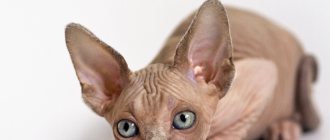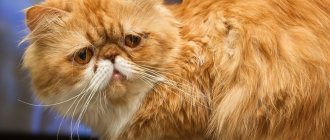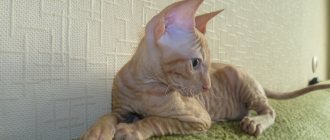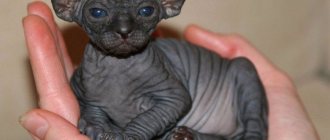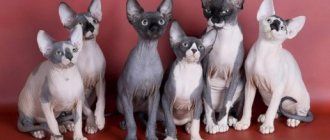Sphynx kittens have both ardent opponents and devoted fans. Many people are horrified first when they see wrinkled, bald freaks. But once you hold a warm, velvety miracle in your hands for the first time, it’s impossible to resist. A kitten with the appearance of an alien from outer space turns out to be unexpectedly pleasant to the touch. And there are legends about the intelligence and character of sphinxes.
But caring for Sphynx kittens is so different from caring for other cats that even an experienced “cat lover”, encountering an unusual pet for the first time, needs additional information.
Sphynx cats: maintenance and care from the very first days in a new home
The most serious problem of Sphynx kittens is that they are afraid of the cold. If an ordinary cat will feel quite comfortable at 18-20 degrees, and for long-haired breeds coolness is even preferable, then the Sphynx will feel quite comfortable only at plus 25 and above. Therefore, when purchasing a Sphynx, immediately think: are you ready to live permanently in “Africa”, how will you provide warmth in the off-season. Alternatively, you can dress the kitten. Typically, Sphynx cats do not mind warm clothes - knitted sweaters and pants, flannelette or fleece overalls.
If you use a heater to raise the temperature in the room or you have fiery radiators, the sphinx faces another danger - trying to warm up, it can get a serious burn. Place your hand on the battery - if it is impossible to hold it, you will have to either cover the radiator with a cover or protect it from the kitten in some other way.
Already from the conversation about temperature, it is clear that caring for a Sphynx kitten needs to be thought out even before you have a warm velvet lump. Open sunlight also poses a serious danger to a Sphynx cat at any age. Sunbathing on a windowsill can cause a kitten to get heatstroke or even burn out. So in sunny weather, carefully monitor your pet and do not allow him to overuse the tan. Sometimes you even have to shade the windows with a special film.
In the first weeks in the new home, the kitten should be fed the same food that it was accustomed to from the breeder. Find out what kind of food you bought for the kittens and buy the exact same one. Let the supply be sufficient for at least 2 weeks. If the child ate “natural food” - food prepared at home from natural products - find out the exact recipe. You will have to prepare the same one. Even if, in your opinion, the diet was completely wrong, it is better not to change anything in the first few days.
If you adopted a Sphynx as a baby - up to 3-4 months (which can only happen with a very irresponsible breeder), then you will have to feed such a kitten with special food for kittens (not dry) 6 times a day. At first, you will have to get up at night - the baby simply cannot spend 8-10 hours alone without food. To prevent the little Sphynx from freezing and getting bored, many owners put him in bed with them. How should we feel about this? If you, in principle, do not mind the company of a cat in your bed and do not sleep too deeply (there is no risk of crushing the baby in your sleep), there is nothing wrong with that. Just understand that subsequently it will not be possible to convince an adult cat to sleep alone on a special bed.
After 4-5 months, you can feed the Sphynx, like any kitten, 3-4 times a day. And after 8-9 months it is quite possible to switch to 2 meals a day. In between meals, the kitten should always have clean water available. It is recommended to use only bottled water. You should not just give boiled tap water, since boiling does not remove many dangerous impurities, and a kitten’s digestive system is much more sensitive than a person’s.
The Sphynx kitten needs more than just warmth and food. Like any child, he wants to play. If the owner does not entertain the baby, he will find entertainment himself. But you are unlikely to like these entertainments. Left to its own devices, the cat will swing on the curtains, carry small things, unwind threads, scatter garbage, dig up and pick off indoor flowers, etc. The list of possible pranks is endless. And the only way to limit them is to pay more attention to the child.
Sphynx eyes, which lack hair and eyelashes, also require special care. They are wiped daily with a clean cotton swab moistened with boiled water or drunken tea. Clear or slightly brownish discharge from the eyes is considered normal. If the discharge is abundant, has a yellow or intense brown color, or an unpleasant odor, you should definitely contact a veterinarian; you should not self-medicate. Before visiting the doctor, you can continue to wash your eyes with weak tea, chamomile solution, and be sure to use a separate swab for each eye so as not to transfer the infection.
Sphynx claws are trimmed as they grow. The procedure is the same as for all other cats.
The vaccination schedule is also no different from other breeds. Typically, the breeder transfers a fully vaccinated kitten to the new owner. So vaccinations will be needed only after a year.
Breed Features
Character
Breeders try to present Canadian Sphynx cats as real angels. But it is not always the case.
- The character of these animals largely depends on the conditions of detention and the behavior of the owner. Sphinxes show affection for people and need close communication with them. From all the inhabitants of the house they choose their owner. And this is not necessarily the head of the family. Canadians prefer someone who is especially affectionate with them, allows them to lie on their laps, strokes them and takes them into their bed at night.
- Canadians are very curious and always want to be involved in the lives of family members. And it doesn't matter what you do. They will jump on the mop while cleaning the floor, chew on the pen you write with, and look at the magazine you are reading.
- The Canadian Sphynx is a very active, playful breed. Therefore, such cats need all kinds of entertainment. If you leave a Canadian without toys and supervision, he will turn the apartment upside down.
Important! Canadian Sphynx cats are very touchy, so they cannot be punished even if they do something wrong. They remember any rudeness from the owner for a long time, and as a result they may completely stop obeying.
Interaction with adults and children
Canadians easily find a common language with all family members, regardless of age. Canadian Sphynxes are wary of strangers. When trying to pet or pick up, they may become aggressive.
These cats simply adore children. Fun games, running around the room accompanied by little companions is a favorite pastime of Canadians. Moreover, they will not even respond to aggression from the child. The Sphynx will prefer to run and hide, but will not bite or scratch the baby.
Relationships with other animals
Hairless cats prefer to be the only pets in the house. They can hardly stand being around other animals. But some individuals are able to find a compromise with their neighbors. They will not feel any special love for other cats or dogs in the house, but they can live at some distance and in a conditionally divided territory.
Bathing a Sphynx kitten
Unlike their furry counterparts, Sphynx cats need frequent bathing. The fact is that their skin has many sweat and sebaceous glands, but does not have wool, for the lubrication of which all this wealth is intended. Therefore, the Sphynx kitten sweats quickly and an unpleasant odor appears. If you delay bathing, greasy crusts may appear on the skin. The skin underneath it itches, becomes inflamed, and the animal begins to scratch it...
Sphynxes are bathed 2-4 times a month. For bathing, use special mild shampoos, preferably specially designed for this breed; in extreme cases, cat shampoos for sensitive skin.
Otherwise, bathing sphinxes proceeds in the same way as other cats. Particular care should be taken when washing your hair to prevent water from getting into your ears. Sometimes it is even recommended to plug them with a cotton swab.
Sphynx ears also require more careful care than other cats. Due to the lack of wool, dust gets into them more easily. After each bath, wipe the inside of the ears with a cotton pad. Moistened with Vaseline oil, carefully and thoroughly treating each fold.
What to feed?
Representatives of this breed have a wonderful appetite, but you cannot give them everything. This is especially true for table scraps and human food.
The digestive system of human bald friends is not adapted to digest confectionery or sausages, spices or smoked meats. It's poison for them. The diet is planned taking into account age characteristics.
Adults
Choose the number of feedings yourself, but it is better to accustom him to a certain regimen . The main thing is that your pet has access to food when he is hungry or cold. Meat must be on the menu. The daily value is approximately 30% of his body weight. There are also useful proteins in fish and cottage cheese. 200-250 g per day is enough.
1/3 of the food consists of carbohydrate components. These are porridges - buckwheat, oatmeal, rice or fresh vegetables. Add 5-10 g of vegetable oil to them. Unrefined is better, it contains more vitamins. In winter, the volume of portions increases.
What does a kitten need for normal development and growth?
The body grows up to 10 months, so it is important for babies to eat properly and fully. From the first month of life they are accustomed to solid food. Let's have some boiled veal. They can’t eat pork, it’s too fatty for them and can cause indigestion. From 6 weeks you can feed with egg yolk and cottage cheese. At 4 months, boiled sea fish is useful in small quantities. Remove the bones from it.
How to care for your Sphynx's skin
After bathing, the delicate skin of the baby sphinx can be smeared with a special cream (if this is not available, regular baby cream will do). This will avoid over-drying with detergents and peeling.
If a kitten sweats and gets dirty more than once a week, instead of bathing, wipe its skin with a special damp cloth or just a piece of damp soft cloth. Particular attention is paid to the folds of the skin, where fat deposits stagnate and crusts are more likely to form. If crusts do appear, do not pick them off with your nails or rub them too hard. So, firstly, you will hurt your pet - and he will no longer trust you to care for his skin, and secondly, you can damage the skin, and then a sore will form. It is better to apply thick baby cream to the crust, and after a couple of hours wipe with a damp cloth. This can be repeated several times. The cream will soften the crust and remove it without effort.
When caring for the skin, special attention is paid to the tail. There are most of the sebaceous glands and glands that secrete a special odorous secretion. It’s not for nothing that cats rub their tails hard against everything. In this way they mark their territory with their scent. Sphynx cats can develop blackheads on their tails. They are carefully squeezed out and the damaged areas are treated with antiseptic agents.
The right diet
In order for the Sphynx to develop well and remain healthy longer, it is provided not only with proper maintenance and care, but also with balanced feeding. To remain active and maintain body temperature, hairless cats require more high-calorie food than representatives of shaggy breeds.
On a note. If the Sphynx's diet is low in fat, the animal will become cold and begin to overeat to make up for the lack of energy. And this is fraught with digestive problems.
With the industrial type of feeding, high-calorie products of premium or super-premium class are purchased for sphinxes. Before making a choice, you need to carefully study the description of the composition and make sure that it has sufficient fat content and there are no questionable components.
The following criteria are met:
- Royal Canin;
- Acana;
- Grandorf.
With a natural diet, the Sphinx's menu is designed so that it contains at least 70% meat. Also included in the diet of cats of hairless breeds is:
- boiled offal;
- porridge with water;
- vegetables;
- eggs;
- dairy products;
- lean sea fish.
It is important to ensure that cats of this breed never eat bones, baked goods, sweets, smoked meats, pickles and sausages. Also, sphinxes should not be given mushrooms, onions, river fish, fresh milk and any leftovers from the master's table.
Types of sphinxes and specific care
Sphynx cats, the care and feeding of which have their own specifics, are not one, but two different breeds that differ not only in appearance, but also have peculiarities of maintenance.
Canadian Sphynx: care and maintenance
The fruit of long selection. Canadian Sphynx cats have thin bones and are often in poor health. Their body is covered with thin, almost imperceptible down, which makes skin care difficult. But there are fewer folds on the skin, so you don’t need to monitor at least this.
You should also pay close attention to dental health - caries and oral diseases are not uncommon among Sphynx cats. You will have to brush your teeth or buy special food. Promoting the removal of tartar, as well as regularly visiting the dentist (!).
The Sphynx's small ears do not pose any particular problems.
Thanks to its long legs, the Canadian Sphynx jumps well and high. This should be taken into account when choosing a kitten. You'll have to reconsider your attitude towards knick-knacks on tables and low open shelves.
Don Sphynx: care and maintenance
An indigenous breed bred from a single “hairless” cat. Don Sphynxes have a much stronger physique and are less prone to various kinds of diseases.
Not as capricious and whimsical as Canadians, they are distinguished by irrepressible energy and curiosity, many of them are willful and require an authoritarian approach when raising them, otherwise the cat will definitely decide that he is the boss in the house and will begin to establish his own rules.
Covered all over with folds and folds, the Don Sphynx will require patience when bathing and grooming. After all, each skin fold will have to be thoroughly washed, dried and treated with cream.
Bat ears also cause anxiety for owners as they accumulate dust and wax. You have to pay a lot of attention to them, carefully treating every bend and fold of the auricle.
History of hairless cats
The first kitten without hair appeared in 1966 in the center of Canada, in the province of Ontario. The cat received the nickname Prune and became the founder of the subspecies of hairless domestic cats. However, at that time, breeders did not have the necessary experience and knowledge, so the special gene was not preserved.
In the future, Sphynx kittens were born in Minnesota. These pets laid the foundation for a new species of cat. Despite the fact that sphinxes were born in the United States, Canada was initially considered their official homeland.
Particularly popular during that period was a cat named Bambi, who was found in Toronto along with a couple of cats. The discovered animals were taken to the Netherlands, where they were crossed with Devon Rex and others like them.
By 1998, the Sphynx cat was formed and officially recognized by the CFA organization. These animals came to the territory of the Russian Federation at the beginning of the 21st century from the USA. After this, breeders began to actively work in terms of breeding similar hairless varieties - Don Sphynxes, Peterbalds (Peterbalds) and Ukrainian Levkoys.
You might be interested in the Devon Rex breed
Feeding: main rules
High-quality, balanced nutrition for the Sphynx is the basis for good health and proper development. Already at the age of 3 months, the animal is allowed to give the first complementary foods. This can be natural food or specialized ready-made factory food intended for a certain age. The following Royal Canin brand foods have proven themselves to be:
- Mother&Babycat;
- Kitten.
Royal Canin brand food is suitable for such animals.
And for adults it is better to buy Sphynx Adult. If the owner prefers to feed from natural products, it is important to ensure that the menu has a balanced content of vitamins, minerals, and protein. Nutrition will be complete if you give your cat daily food such as:
- lean meat;
- boiled fish without skin and bones;
- vegetables: cauliflower, zucchini, pumpkin, boiled beets;
- cereals;
- hard unsalted cheese without additives;
- cottage cheese, kefir, yogurt, fermented baked milk.
In addition to quality nutrition, it is important to provide the animal with clean drinking water, which should always be fresh and freely available.





